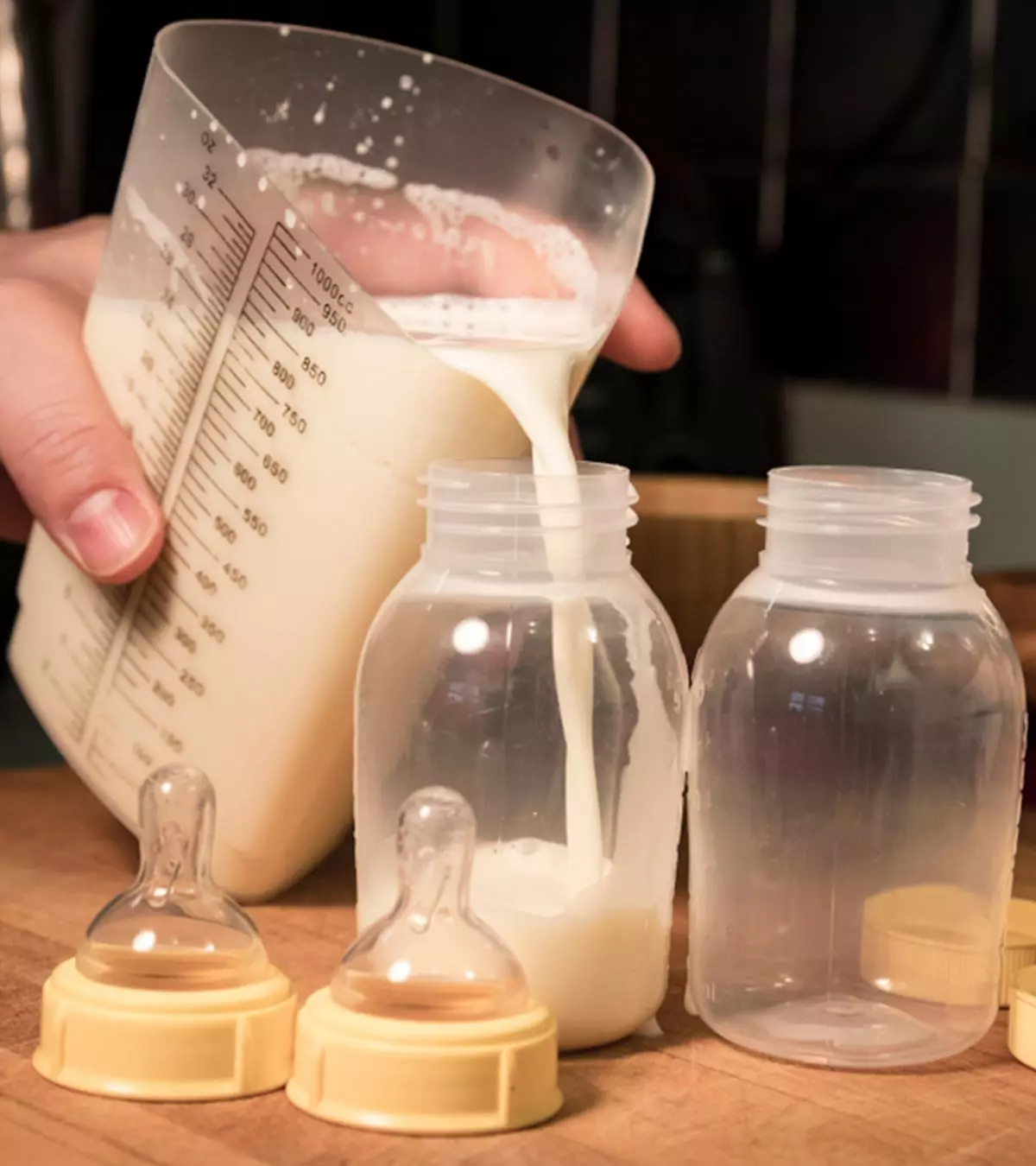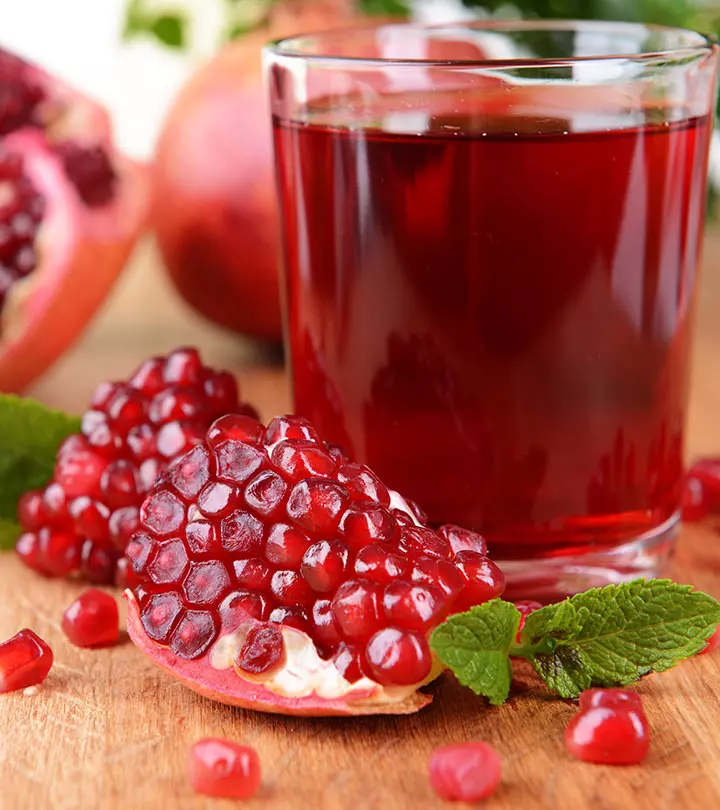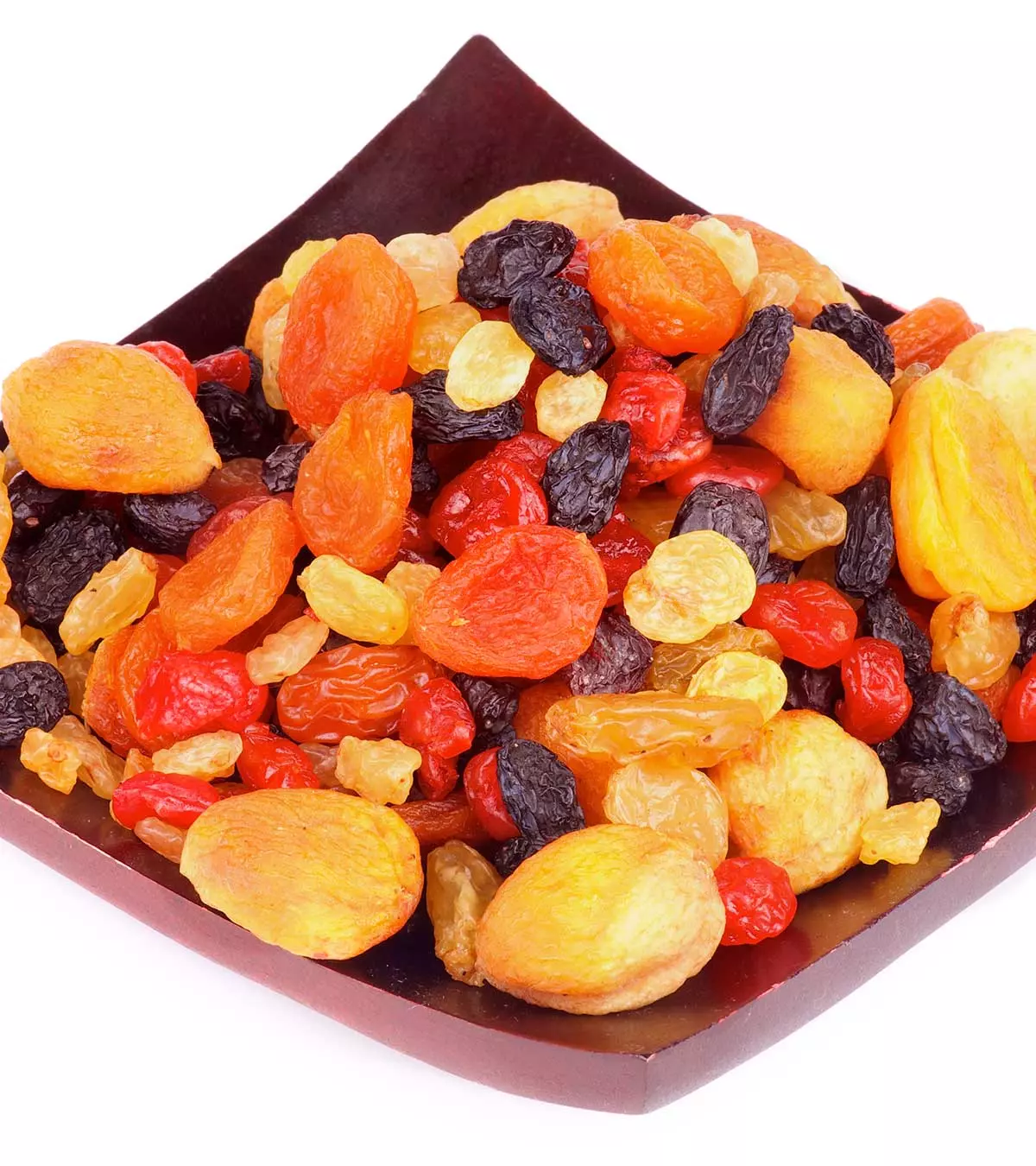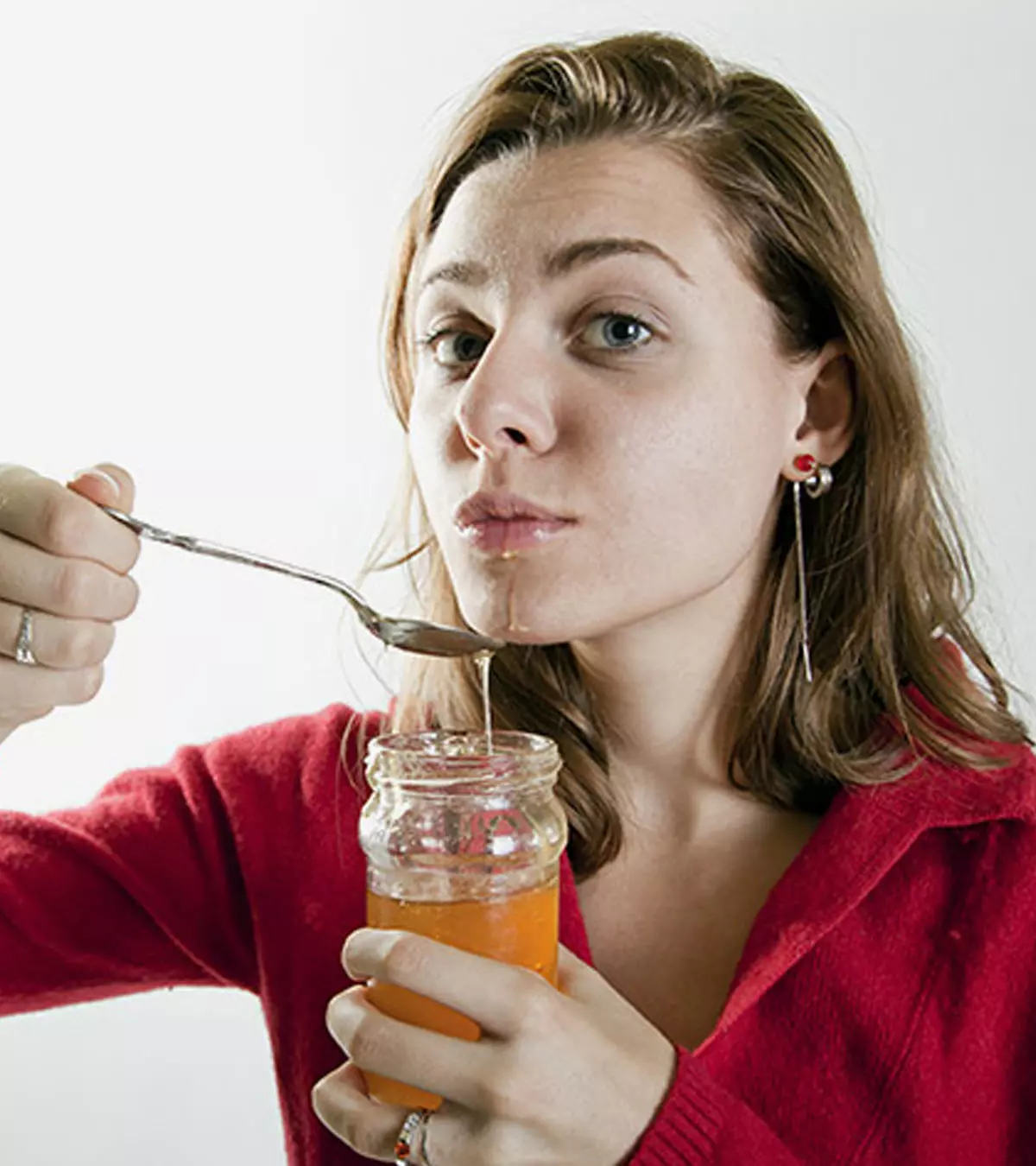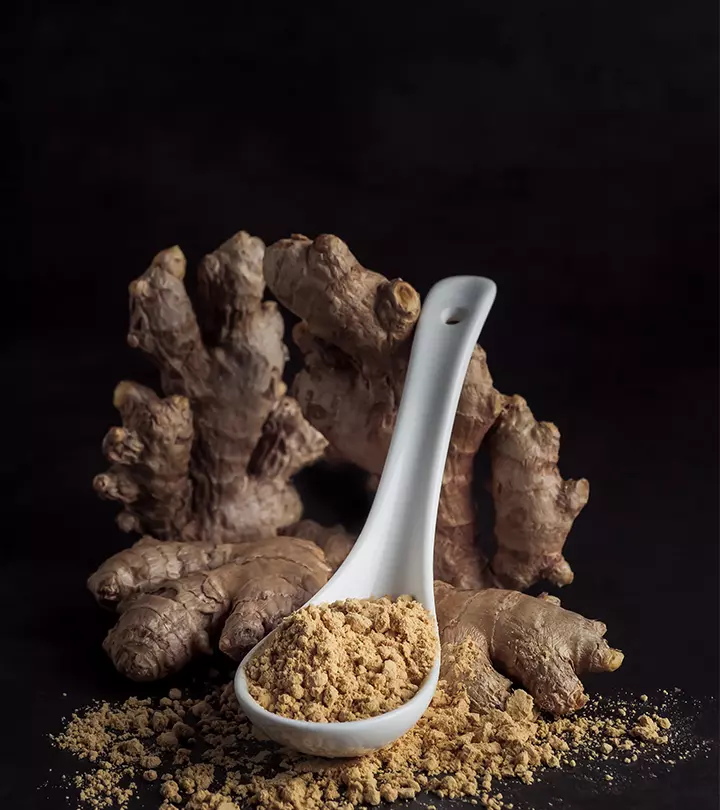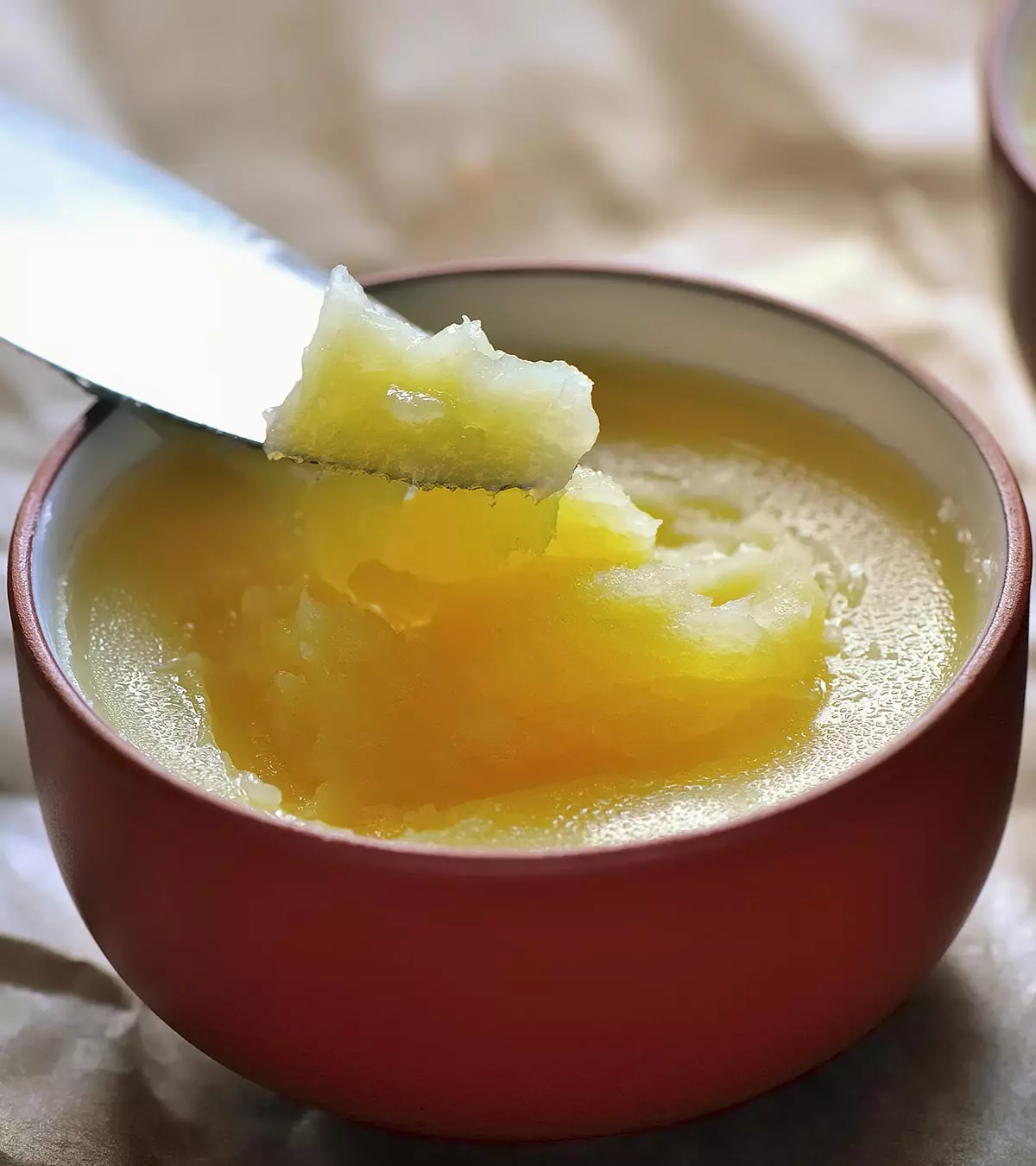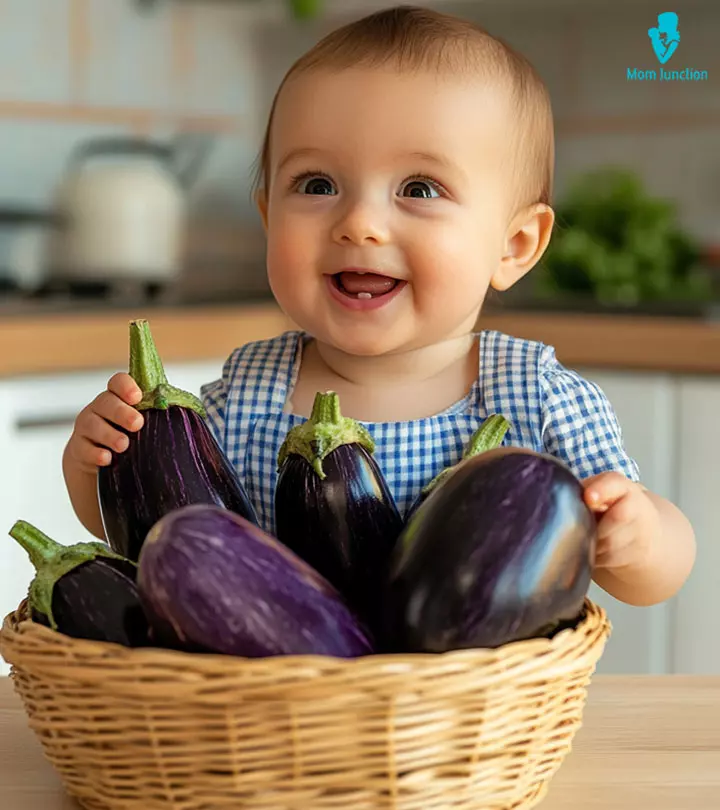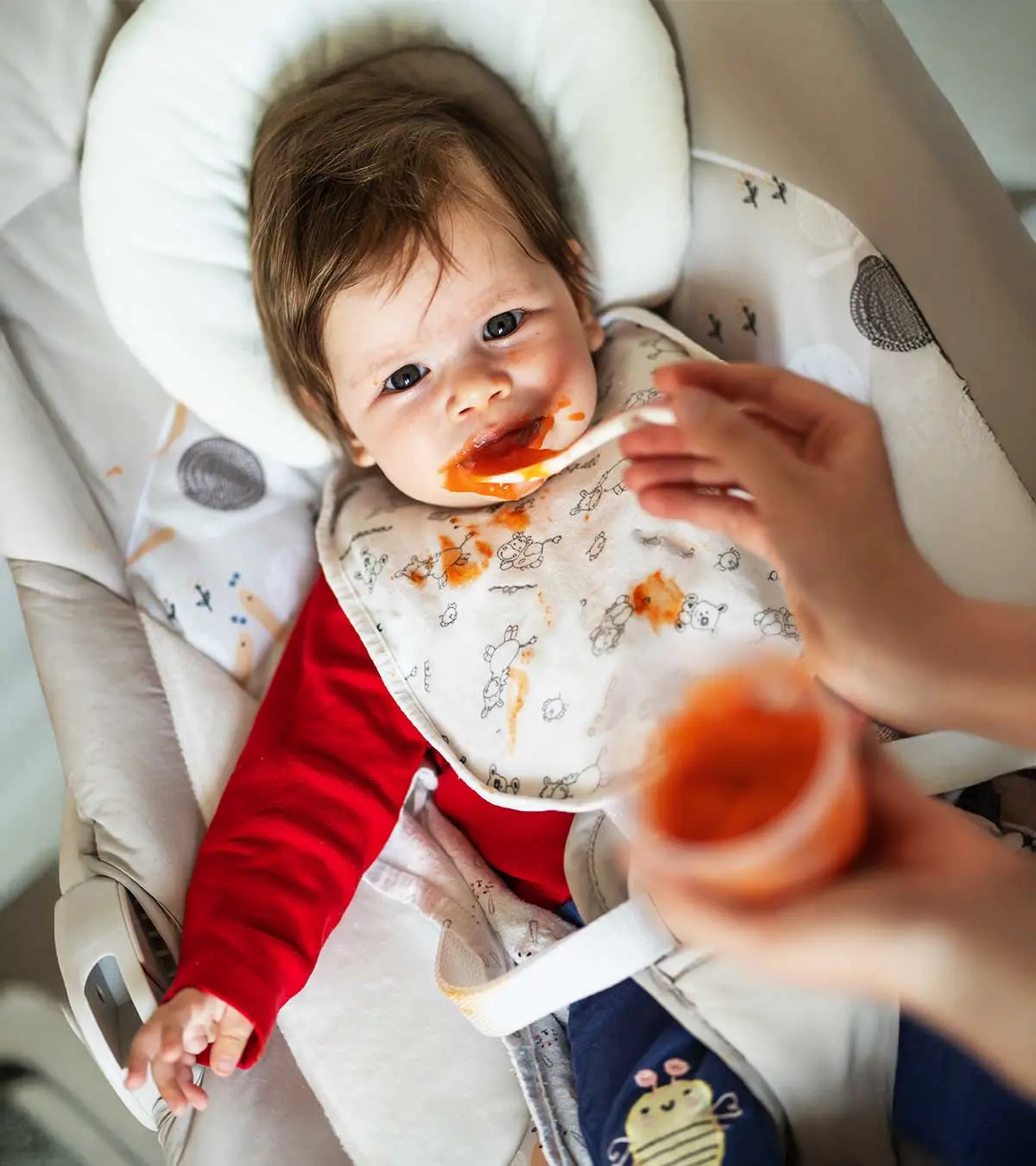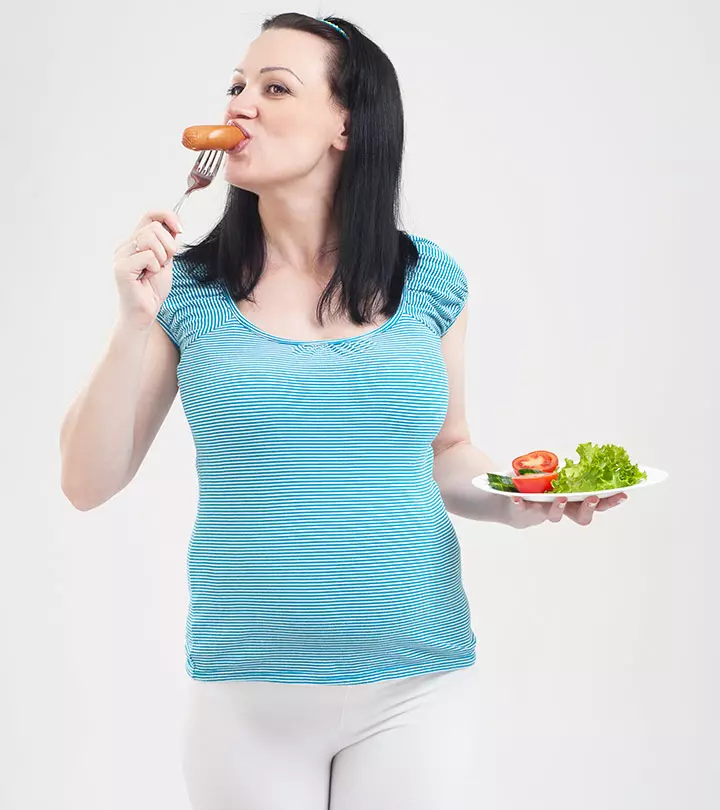
Image: ShutterStock
Sausage is a ubiquitous food popular for its spicy taste and crumbly texture. But though people like it, it’s also a highly processed food high in saturated fat, sodium, and nitrosaminesiCompounds whose constant exposure may increase the risk of certain cancers in an individual . So, can you eat sausage when pregnant? Learning this is essential as eating highly processed foods can expose you and your unborn baby to several health risks.

Read on as we tell you all about different types of sausages, their safety for pregnant women, some health benefits, side effects, and tasty sausage recipes to try making at home.
Key Pointers
- Sausages can be a part of a pregnancy diet after consulting a doctor, as they are made from a combination of red and poultry meats
- They can offer benefits such as building muscle strength, preventing anemia, and metabolizing body fat and proteins in pregnant women.
- However, fresh and smoked or cooked sausages should be stored properly, cooked thoroughly, and consumed while hot to reduce the risk of bacterial infections like listeriosis.
- Dry and semi-dry sausages, which are cured with salt and sodium nitrite, should be avoided during pregnancy.
- Potential side effects of consuming sausages during pregnancy include weight gain, listeriosis, toxoplasmosis, abdominal cramps, heartburn, and other fetal complications.
Is Sausage Safe To Eat During Pregnancy?
One thing that crosses your mind when you see sausages is that can you eat sausage when pregnant. Will it be safe for you and your growing child? So, sausage is safe to eat during pregnancy if it is completely cooked and eaten hot. Sausages made of ground beef, pork, lamb, or veal should be to 165°F. (1)
You need to cook the meat until there is no more pink left inside and the juices dry up (2). With all these precautions, however, do make sure to check with your doctor before you plan to include sausages in your diet for a healthy pregnancy.
Types Of Sausages: What Is Safe And What Is Not
Sausages are made of ground red meat or poultry and have a casing made from the intestine of the animal. They could be pan-fried, broiled, or barbecued.
The processed meat product is available in uncooked and ready-to-eat forms. Fresh and smoked sausages are uncooked while dry, semi-dry, and cooked are ready-to-eat. Know if you can or cannot eat each variety, here (3) (4):
1. Fresh sausages
Fresh sausages are finely chopped particles of meat, which are usually cured and seasoned. The varieties include fresh pork sausages, fresh beef sausages, breakfast sausages, whole hog sausages, and Italian sausage products.
Safety during pregnancy: Fresh sausage is safe to eat if you refrigerate it properly and cook thoroughly. Uncooked sausages may contain listeria and hence are unsafe to eat (4).
2. Cooked and/or smoked sausages
Cooked or smoked sausages are made of chopped or ground meat.
They are seasoned, cooked, and/or smoked. This category includes liverwurst, hot dogs, bologna, cooked bratwurst, braunschweiger, cooked Thuringer, and salami.
Safety during pregnancy: Do not consume seasoned sausages unless they are completely cooked and are piping hot.
3. Dry and semi-dry sausages
Dry and semi-dry sausages are cured with salt and sodium nitrite, cultured, mixed with ground or chopped meat, placed in casings, fermented and then dried. Semi-dry sausages are partially dried. Pepperoni, Lebanon bologna, and summer sausage come under this variety.
Safety during pregnancy: The fermentation process and lack of moisture usually kill the pathogeniciMicrobes that are capable of causing diseases, including bacteria, viruses, worms, protozoa, and fungi bacteria in dry sausages. However, it is good to avoid dry sausages when you are pregnant as a few types of bacteria, such as E.Coli, can survive the dry fermentation process. (4)
 Point to consider
Point to considerSide Effects Of Sausages During Pregnancy
While you can ensure that a home-made sausage is safe to consume, there is no guarantee that a ready-to-eat product is free from food-borne diseases. A sausage can affect your prenatal health in more ways than one:
1. High fat and salt (sodium) content
Two links of pork sausage contains 170 calories and 15g fat. Foods high in calories could lead to excess weight gain, which could pose problems during and after the pregnancy. So, the type and quantity of sausage should be selected cautiously during pregnancy.
Two sausages can meet 50% of your daily sodium requirement of 6g. Sausages are the third largest individual contributors of salt in our diet. A survey in the US has shown that many sausages are full of ‘hidden and unnecessary salt’ (5). The sodium content in sausages can range from 100mg to nearly 2g.
High sodium levels can affect fetal renal development (6) and may also affect the mother’s health. Thus, eating sausage without bun is a good idea as the bun can add another 180-200mg of sodium to the meal (7).
2. Listeria
Listeria monocytogenes is a bacteria that can lead to listeriosisi Food-borne bacterial infection in pregnant women characterized by diarrhea and fatigue, and flu-like symptoms disease. Listeriosis can result in miscarriage, severe sickness, premature birth, or death of a newborn. Fermented or dry sausages carry the risk of listeria which can lead to a foodborne illness (8).
3. Toxoplasmosis and other bacteria
ToxoplasmosisiParasitic infection often caused by consumption of contaminated raw meat or exposure to cat feces is very rare in pregnant women but could be dangerous. It leads to fetal development problems, such as brain damage or blindness in the baby, premature birth, jaundice, and psychological development issues. Toxoplasmosis is caused by Toxoplasma gondii present in raw and uncooked meat. (9)
Poorly cooked sausages could be carriers of other bacteria such as salmonellaiBacterial genus capable of causing contagious infections in the human intestine and E.coli. Salmonella causes diarrhea, vomiting, fever, dehydration, and abdominal cramps. According to a report by the World Health Organization, Salmonella is one of the four main global causes of diarrheal diseases. On the other hand, E. coli can lead to various health issues, including anemiaiA condition characterized by reduced levels of red blood cells and hemoglobin in the body during pregnancy and urinary tract infections, among others.
4. Heartburn
The high amount of spices added in sausages could result in heartburn (10), especially in the third trimester, when the uterus expands to accommodate your growing baby, and presses on to your abdomen. The expansion pushes the acid back into the esophagus. This is not harmful to the baby, but the acidity will make you uncomfortable.
Having a glass of milk after a sausage may avoid this irritation.
Benefits Of Eating Sausage
Would processed meat like sausages have any health benefits? Yes and, here are a few that may add to your pregnancy nutrition. However, you need not consume sausages for these benefits alone because you may get these from other healthier foods too.
- Sausages contain all the nine amino acids and can increase the protein intake required to maintain your muscle strength (11).
They are rich in vitamin B-12 needed to make hemoglobin and metabolize the body fats and proteins (12). - Iron intake is necessary for a pregnant woman to maintain hemoglobin levels and to avoid anemia. A 1oz cooked pork sausage has 0.34mg of iron (13).
- An important point to consider is that these benefits are also present in foods that are healthier than sausages.
7 Safety Tips To Eat Sausages
Pregnancy food cravings make you defy reason, but they also result in guilt pangs after you indulge in them. Here are a few tips for you to eat sausage without the baggage of guilt by taking into consideration food safety precautions:
- Eat sausage when it is fresh and hot. If you are eating it outside, ask the vendor to reheat it for you.
- Do not eat undercooked sausages.
- Refrigerate the leftover sausage and eat it within two days, but only after reheating it until it is steaming hot (14).
- Even if you buy precooked sausages, reheat them before eating.
- Avoid raw meat consumption and also keep it away from cooked food. Additionally, ensure that juices from uncooked meat are not dripping into other foods.
- Check the labeling of both uncooked and ready-to-eat sausages.
- Select the ones that have low levels of sodium and spices.
12 Tasty Sausage Recipes
1. Quick sausage and squeak

You will need:
- 8 sausages
- 2 chopped celery sticks
- 3 chopped mushrooms
- 2 chopped onions
- 3 chopped carrots
For the squeak:
- Any amount of vegetables you wish to use
- Any amount of mashed potato you wish to use
- 1 egg yolk
- Cheese for topping
- Salt as per taste
- Black pepper as per taste
- Oil
- Ready made gravy or leftover gravy
How to:
- Preheat the oven to 200º C.
- Heat the oil and cook the sausages till they turn golden brown.
- Take a medium casserole dish and add the sausages, onions, carrots, celery sticks, and mushrooms.
- Add the gravy and stir it until it mixes well. Place it in the oven and let it cook for about 30 to 35 minutes.
- As the sausage and vegetables are cooking in the gravy, take the mashed potato and mashed vegetables and add egg yolk to it. Add the salt and pepper as per taste. Now place it all on the grill and heat for some time with a little sprinkling of cheese.
- Once the sausage and gravy are done, serve with the mash.
2. Italian sausage and rocket penne
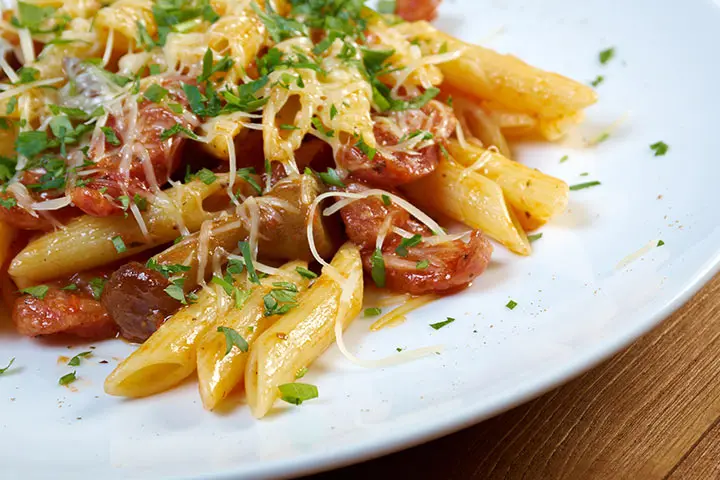
You will need:
- 2tbsp olive oil
- 1 diced red capsicum
- 2 sliced brown onions
- 1kg Italian sausages
- 2 crushed garlic cloves
- 1 cup water
- 500g penne pasta
- 3 cups baby rocket
- Salt and pepper to taste
- ½ cup grated parmesan cheese
How to:
- Heat the oil in a frying pan and add the onions and capsicum. Cook them till they turn a little soft. Take them off the pan and place them aside.
- In the same pan, add a little oil and the sausages and keep cooking until they are fried thoroughly.
- Add the onion, capsicum, and garlic to the pan. Saute them for about two minutes. Add water and stir everything well.
- Cook the pasta as per the instructions on the package. Drain and toss it into the pan.
- Mix the pasta well with the sausage and vegetables. Add salt and pepper. Remove the pan from the heat and add the baby rocket.
- Sprinkle cheese just before serving.
 Quick tip
Quick tip3. Chorizo sausage salad
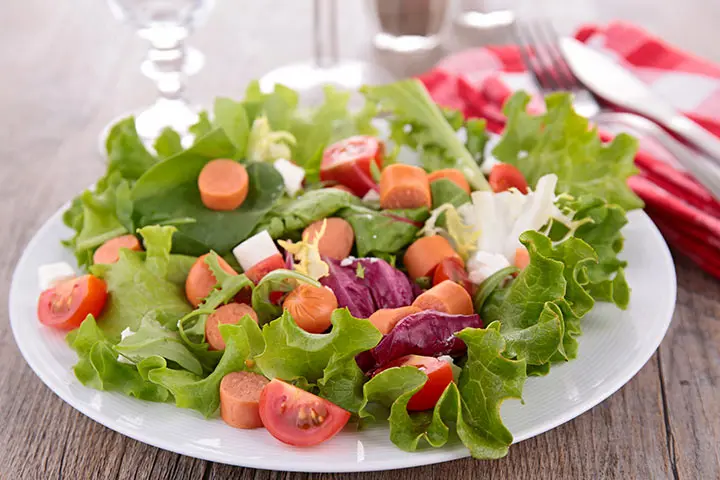
You will need:
- 2 medium chopped red onions with the roots intact
- 2tsp olive oil
- 6 fresh chorizo sausages
- 2 bunches rocket
- Whole baby beetroot
- 200g feta cheese
- For Dressing:
- 4tbsp extra virgin olive oil
- 2tbsp vinegar
- 2tsp honey
How to:
- Preheat your oven to 220ºC.
- Place the onions on a tray lined with baking paper. Add some olive oil on top and bake for about 25 minutes.
- Heat a pan over high heat and cook the sausages. Make sure you cook for at least three minutes on each side, till they are properly cooked and are golden brown. Remove from the pan and slice them lengthwise.
- Put the sausages back in the pan and continue cooking, making sure that the cut side faces down. Cook for three to four minutes or till they are completely cooked.
- For the dressing, add all the dressing ingredients in a jar and give it a good shake. Wash the rocket and add it to the dressing. Place the dressing on the plate and top it with baked onions, baby beetroot, and chunks of feta cheese.
- Add sausage on top and drizzle over the remaining dressing.
4. Fruity curried sausages
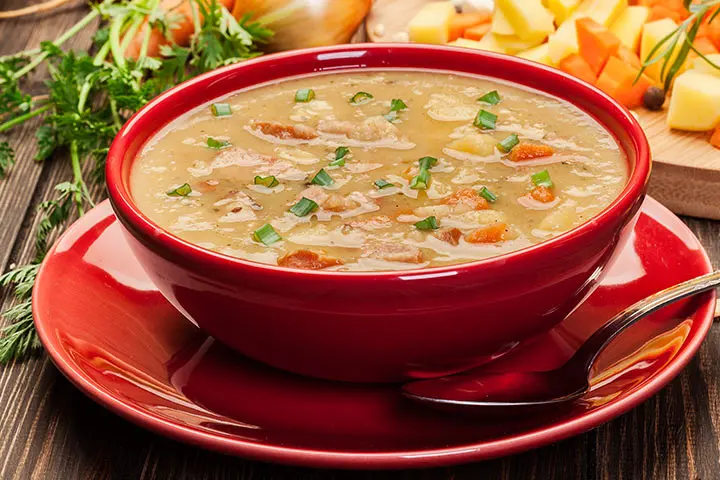
You will need:
- 1tbsp olive oil
- 20g butter
- 2 finely sliced onions
- 1tbsp corn flour
- 1tsp curry powder
- 500ml chicken stock
- 2tbsp apricot jam
- 6 cooked and chopped sausages
- 90g sultanas
How to:
- In a pan, heat the oil and butter together.
- Add onions and cook for about five minutes. Add corn flour and curry powder and cook for another one minute.
- Next, add chicken stock and stir everything together to mix it well.
- Let it all come to a boil. Once it starts to boil, reduce the heat and let it simmer for about ten minutes. Add the jam and the sausages and stir again. Now add the sultanas and cook for another five minutes.
- Remove from heat and serve with warm rice and vegetables.
5. Honey and balsamic glazed sausages
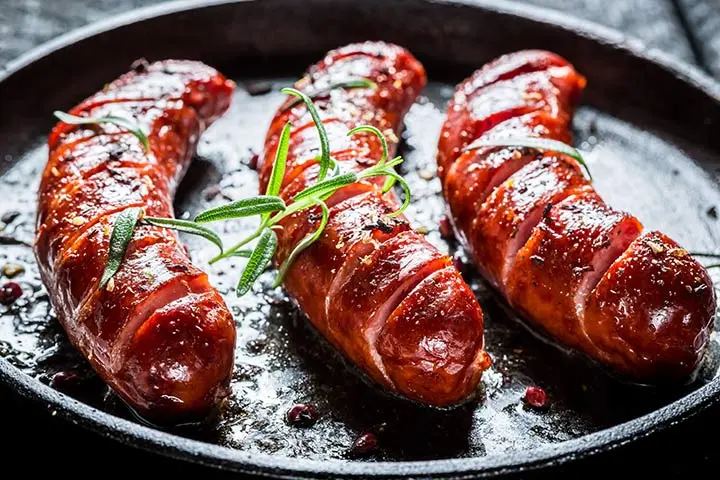
You will need:
- 1tsp olive oil
- 6 sausages
- ¼th cup brown sugar
- 2tbsp balsamic vinegar
- 1tbsp honey
- 2tsp Dijon mustard
- 1 sprig of rosemary
How to:
- In a pan, heat the oil and add sausages. Cook them for about 12 to 15 minutes, or till they turn golden brown and are completely cooked.
- Take another pan and mix balsamic vinegar, sugar, honey, and mustard. Let it boil and then remove from heat.
- Once the sausages are done, remove them from the pan and drain away any fat that may be in the pan. Put the sausages back on the pan and keep the heat on medium.
- Add vinegar, honey, sugar, and mustard glaze that you prepared and drizzle it on the sausages. Add the rosemary.
- Let it all simmer for about two minutes and make sure you keep stirring the sausages so that they do not get stuck at the bottom of the pan.
- Keep cooking till the sausages are fully cooked and are covered in the glaze.
- You can serve it with mashed potatoes and a salad. Add any leftover drizzle on top of potatoes and salad.
6. Sausage hotpot
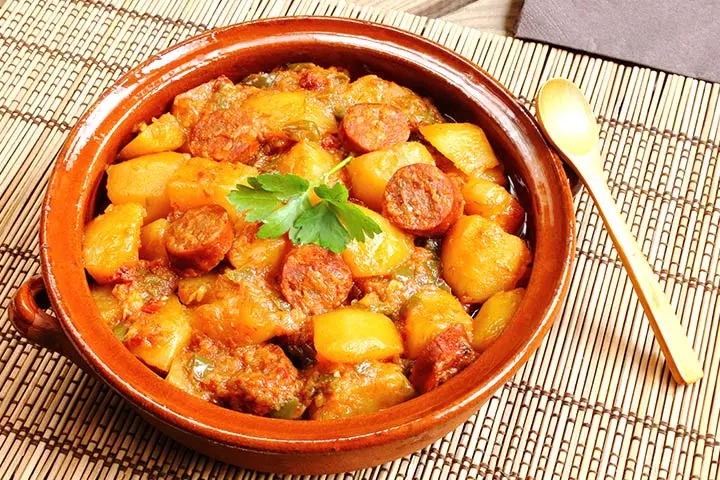
You will need:
- 600 g sausages
- 2 diced rashers bacon
- 1 diced onion
- 1 diced carrot
- 1 diced potato
- 1 finely crushed garlic clove
- ¼tsp Tabasco sauce
- 6 to 8 chopped basil leaves
- ¼tsp dried thyme
- 1 cup beef or chicken stock
- 1tsp tomato paste
- 2 stalks chopped parsley
- 420g diced tomatoes
- 420g flour bean mix
- 1 cup cooked pasta
- Water
How to:
- Boil some water in a pan and add the sausages.
- As the sausages are simmering in the water heat the oil in a pan. Next, add onion, bacon, potato, carrot, and garlic. Keep frying till the onions turn soft.
- Now add Tabasco sauce, thyme, and basil and then add the tomatoes. Keep cooking it on low heat.
- Once the sausages are cooked, remove them from the pan. Peel off the skin of the sausages and chop them into small pieces.
- Add sausages, bean mix, stock, tomato paste, and pasta and let it all cook together for a while. Simmer on low heat for about five to ten minutes and serve immediately.
7. Sausage kebabs
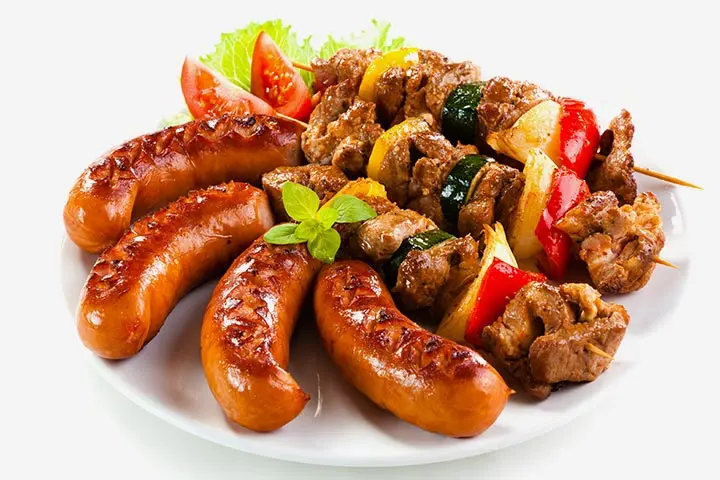
You will need:
- 1 small red onion
- 1 medium zucchini
- 500g chipolata sausage
- 8 cherry tomatoes
- 2tsp olive oil
How to:
- Preheat your oven to 200º C.
- Peel the onions and slice them into wedges. Cut up the zucchini into smaller rounds but keep them thick. Add a wedge of onion and one round of the zucchini to a skewer.
- Now add two chipolata sausages and top it up with a cherry tomato.
- Place the skewers on an oven tray that is lined with baking paper. Drizzle some olive oil over the kebabs and bake for about 20 minutes. Turn the sausages and the skewer halfway through the time so that they cook properly on all sides. At the end of it, the sausages should turn completely brown.
- Serve with a healthy salad.
8. Cowboy casserole
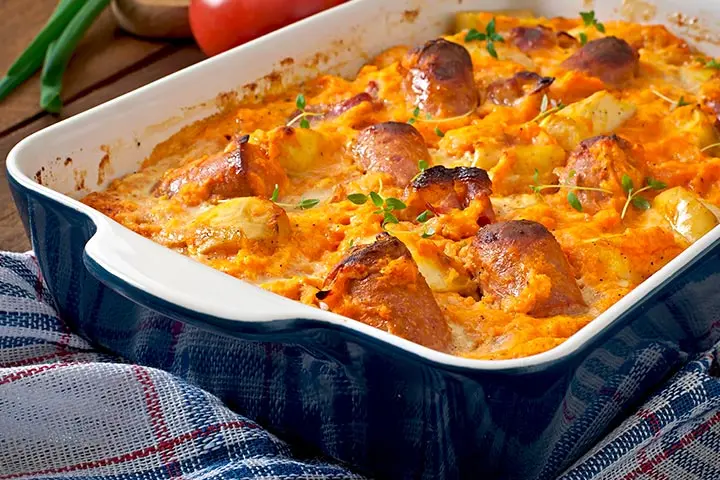
You will need:
- 600g baking potatoes
- 8 sausages
- 1 diced onion
- 2 diced carrots
- 400g baked beans
- 400g mixed and drained beans
- 2tbsp sunflower oil
- 300ml beef or chicken stock
- 2tsp curry powder
- 1tbsp tomato puree
- 50g grated cheddar cheese
- Water
How to:
- Preheat the oven to 180ºC.
- Peel and chop the potatoes and put them to boil in a pan of water.
- Heat the oil in a pan and fry the sausages. Once they are done, remove them from the pan and keep them aside on a plate.
- In the same pan in which you fried sausages, fry the onions and carrots.
- Now add the beans, tomato puree, curry powder and stock. Let it all simmer for about ten minutes.
- Once the potatoes are done, drain them from the water and mash them using the back of a big spoon or ladle.
- Lay the sausages at the bottom of a casserole dish but keep some sausages aside to use as a garnish later.
- Add the bean sauce on the top and put the potato mash.
- Cut the remaining sausages in half and add them inside the mashed potato.
- Place the dish in the oven at a temperature of 180º C. Cook for about 15 to 20 minutes till the sausage and the potato mash have turned a nice golden brown color.
9. Gluten free sausage rolls

You will need:
- 400g gluten free puff pastry
- 400g gluten free sausages
- 1tbsp finely chopped fresh parsley
- 1tsp finely chopped fresh sage
- Salt as per taste
- Black pepper as per taste
- 1 beaten egg
How to:
- Preheat your oven to 220ºC.
- Roll out the gluten free pastry puff in a rectangular shape. Make it about 30 cm.
- Remove the meat of the sausage from the sausage skin and mix it in a bowl along with parsley and sage. Add salt and pepper to season well.
- Now spread the meat of the sausage over the pastry. Make sure you do it in a very thin layer and leave some space around the edges.
- Brush the edges with the beaten egg.
- Start rolling the pastry starting from the short ends at each side. Roll them in towards the middle. As you keep moving, brush the pastry with the beaten egg.
- Once the pastry has reached till the middle, use a knife to help cut up the roll. Try to cut it in about 10 to 12 slices.
- Now put the rolls of sausage on a baking tray, which should be lined with baking paper.
- Brush the sausage rolls with the beaten egg and bake it for about 15 minutes, or until the sausage rolls turn golden brown.
- Let it cool properly before serving.
10. Creamy curried sausages
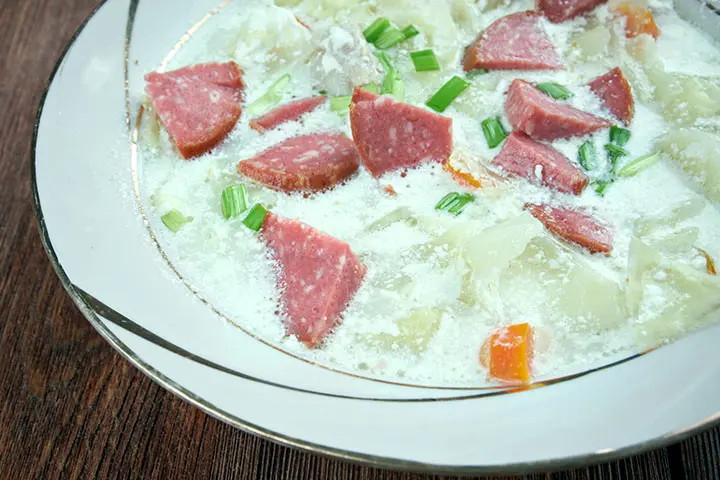
You will need:
- 5 thick sausages
- 1 sliced onion
- 1 diced carrot
- 1tsp sweet paprika
- 1tsp turmeric
- 1tsp curry powder
- Freshly cracked pepper
- 2 sliced zucchini
- 100g green beans
- 1 tin light and creamy evaporated milk
- 1 glass water
- 1tsp corn flour
- 1tbsp brown sugar
How to:
- Heat a pan and add oil. Once the oil is hot, add sausages and cook till they are done. The color should turn to golden brown. Set aside and slice up the sausages. Remove the residual oil from the pan.
- In the same pan, add carrots and onions and cook till the onions turn transparent.
- Now add paprika, turmeric powder, brown sugar, curry powder, and pepper. Keep stirring and fry it all for about two minutes.
- Once they are done, add sliced sausages in the pan. Now add the light and creamy evaporated milk and stir everything together.
- In a glass of water, add corn flour and mix it properly with a spoon, making sure there are no lumps. Once it dissolves, add it to the pan and keep cooking while constantly stirring, till the sauce becomes thick.
- Now add beans and zucchini and cook for another three minutes.
- Serve it with warm rice or mashed potatoes.
11. Sausage and spinach lasagna
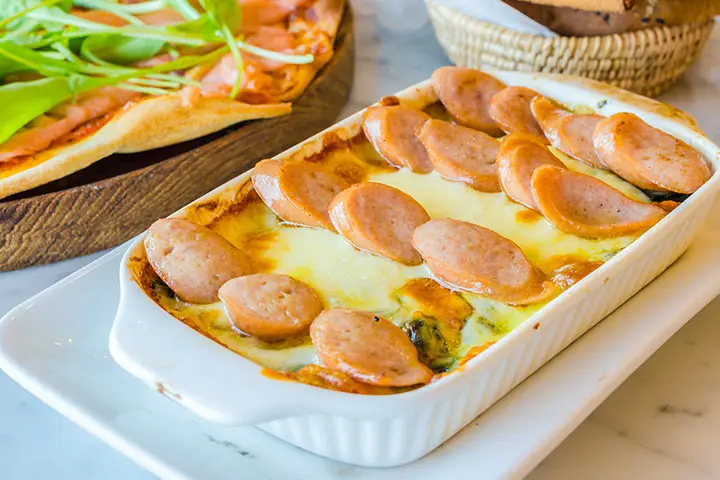
You will need:
- 1tbsp olive oil
- 1 diced onion
- 1 crushed garlic clove
- 400g chopped tomatoes
- 700g tomato passata
- 250g frozen spinach
- 3 sheets fresh lasagna
- 8 cooked and lengthwise halved sausages
- For the Béchamel sauce:
- 30g butter
- 1tbsp plain flour
- 1½ cups warm milk
- 1 cup grated tasty cheese
How to:
- In a pan, heat oil over medium heat. Add garlic and onion and cook for about five minutes till the onions turn translucent. Add tomatoes and tomato passata. Let it all simmer for about 25 minutes.
- Add spinach and cook for another ten minutes.
- For béchamel sauce, melt butter in a pan. Add the flour and keep whisking. Cook it properly for about one minute and keep stirring constantly.
- Slowly, add milk and keep stirring to make sure that it does not stick to the bottom of the pan.
- Let the sauce simmer gently for a few minutes till the sauce has become thick. Once done, remove it from the heat and add half of the cheese to it.
- Preheat the oven to 190ºC.
- In a lasagna dish, place a few spoons of the tomato spinach sauce at the base. Now add one sheet of lasagna on the top. Take eight sausage halves and place them on the top of the lasagna sheet. Add the remaining tomato and spinach sauce over the sausages. Add another sheet of lasagna and layer again with the sauce.
- Once you complete your layering, make sure you put the last layer on the lasagna sheet. Now pour the béchamel sauce on top and add the remaining half of the cheese.
- Bake it all for about 35 to 40 minutes or till it turns golden brown, and the cheese starts to bubble.
12. Baked sausages and butterbeans
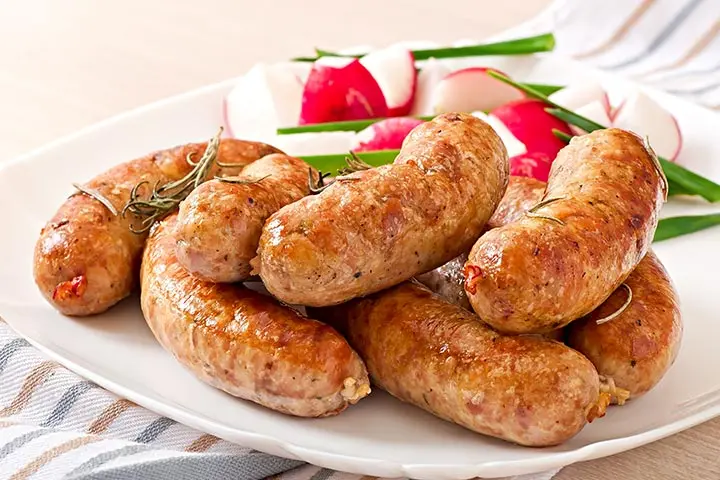
You will need:
- 1 sliced brown onion
- 6 large sausages
- 2 sliced capsicums
- 400g drained butterbeans
- 2 thinly sliced garlic cloves
- 2tbsp thyme leaves
- 400 g chopped tomatoes
- Parsley for garnish
How to:
- Preheat the oven to 180ºC.
- In a non-stick roasting tray, place the onions, capsicums and sausages and place it in the oven. Make sure you cook it for about 20 minutes.
- After 20 minutes, remove the pan from the oven and add butter beans, thyme, garlic, and tomatoes to it. Mix it well.
- Now add 3/4th cup of hot water to the mix. If you feel that it looks a bit dry, you can add some more water so that the mix looks nice and juicy.
- Add the sausages back on the mix and cover it using a sheet of foil. Place the dish back in the oven and cook it for another 20 minutes.
- Once done, remove the foil carefully and cook for another ten minutes and then take the dish out of the oven and set it aside to cool for a while. Sprinkle the parsley on the top right before you are about to serve it.
If you are not comfortable with any of the ingredients above, substitute them with some alternatives. Your health and comfort should help you decide what and how you eat.
Frequently Asked Questions
1. Can I eat chorizo during pregnancy?
Chorizo is pork sausage seasoned with garlic. You can eat it in moderate quantities during pregnancy if it is cooked properly. If you are allergic to spices, avoid it. Raw chorizo should not be eaten. Consult a nutritionist to make a wise decision while selecting sausages during pregnancy.
2. Is hot sausage safe during pregnancy?
Hot sausage enhances the taste of your sandwich or soup. You can have it but it is not a good choice when you are trying to eat healthy. If you are craving for one, have it in moderation.
3. Can I eat a Vienna sausage during pregnancy?
You must avoid Vienna sausage during pregnancy since it is made from pre-cooked meat with high sodium nitrate and nitrite content. They also contain spices, herbs, and other additives that may be unsafe for a pregnant woman. High sodium levels may create trouble for women with swollen legs due to water retention. Spices could aggravate heartburn during pregnancy.
4. What are Italian sausages? Can I consume them during pregnancy?
Italian sausages contain more than 85% meat and fat. The total fat content is up to 35% of the cooked product. It has salt, spices, pepper, onion, garlic, sugar, dextrose, and corn syrup. It is high in calories, which could add fat to your body.
Spices may give you heartburn, but eating them occasionally will not cause maternal health issues. A DIY sausage can be a healthy alternative. It will give you the freedom to use lean meats, fresh herbs, a lot of vegetables, and limited salt (15).
5. Can sausage cause gestational diabetes during pregnancy?
Sausage is usually considered fast food. Overconsumption of such fast foods during pregnancy could be a risk factor for gestational diabetes (16).
6. Can sausage cause high blood pressure during pregnancy?
Sausages contain high concentrations of salt, a source of sodium. A study shows that excessive sodium intake during pregnancy may increase the risk of hypertensive disorders (high blood pressure) in pregnant women (17).
7. Can sausage cause constipation during pregnancy?
Foods rich in sodium, especially processed foods and meat products, are low in fiber and water. Additionally, excessive salt can decrease the amount of water in the stool and cause constipation. Furthermore, some studies have shown that a high-salt diet might alter the microbiota in the intestines and harm the digestive process (18).
8. What are the signs of foodborne illness during pregnancy?
Signs of foodborne illness during pregnancy can include nausea, vomiting, diarrhea, abdominal pain, fever, and body aches. These symptoms may feel similar to flu but can sometimes be more intense or last longer. If symptoms are severe or don’t improve, consult a healthcare provider (19).
9. What should I do if I experience food poisoning symptoms after eating sausage?
If you have food poisoning symptoms after eating sausages, report the incident to your healthcare team. Doing so can help address food safety issues and prevent further complications (19).
Sausage is something which is eaten to satiate your cravings during pregnancy but not for any health benefits. Choose healthy alternatives to classic sausage ingredients. Adding fresh vegetables, herbs, whole grains such as barley and homemade sauces with limited sodium can help you make a healthy version of sausage.
Infographic: Safety Tips To Eat Sausages When Pregnant
Along with mood swings, nausea and vomiting, pregnancy also comes with food cravings. Sausages are one such food you might crave for. They are tasty and savory, but you must take certain precautions when eating them during pregnancy. So, check out the infographic below to learn some safety tips.
Some thing wrong with infographic shortcode. please verify shortcode syntax
Pregnancy requires a lot of precautions, especially with respect to foods like sausage. Watch this video to find out whether sausage is safe for your baby.
References
1. Cooking Meat? Check the New Recommended Temperatures; USDA
2. Foods to avoid in pregnancy; NHS
3. What Are The Types of Sausage Casings?; American Meat Science Association
4. Sausages and Food Safety; USDA
5. Sausage Survey; Action on Salt
6. Caiping Mao et al.; High-salt diets during pregnancy affected fetal and offspring renal renin–angiotensin system; National Center For Biotechnology Information (2013)
7. A Guide to Hot Dog and Sausage Nutrition; National Hot Dog and Sausage Council
8. Listeria And Pregnancy; American Pregnancy Association
9. About Toxoplasmosis; CDC
10. Acid Reflux; Keck Medicine
11. Are Animal Proteins Better for You Than Plant Proteins?; Cedars Sinai
12. Judy Cunningham et al.; Nutrient Composition of Retail Samples of Australian Beef Sausages; National Center For Biotechnology Information (2013)
13. Nutrition Facts; Turkey and pork sausage; University Hospitals
14. How to store food and leftovers; NHS
15. The Art and Practice of Sausage Making; North Dakota State University
16. Ligia J. Dominguez et al.; Fast Food Consumption and Gestational Diabetes Incidence in the SUN Project; National Center For Biotechnology Information (2014)
17. Mariel Arvizu et al.; Sodium Intake During Pregnancy, but Not Other Diet Recommendations Aimed at Preventing Cardiovascular Disease, Is Positively Related to Risk of Hypertensive Disorders of Pregnancy; National Center For Biotechnology Information (2025)
18. Maurane Rollet et al.; Association between Dietary Factors and Constipation in Adults Living in Luxembourg and Taking Part in the ORISCAV-LUX 2 Survey; National Center For Biotechnology Information (2025)
19. What Is Foodborne Illness? (Food Safety for Moms-to-Be); U.S. Food & Drug Administration
Community Experiences
Join the conversation and become a part of our nurturing community! Share your stories, experiences, and insights to connect with fellow parents.
Read full bio of Jyoti Benjamin
Read full bio of Swati Patwal
Read full bio of Rebecca Malachi
Read full bio of Reshmi Das





